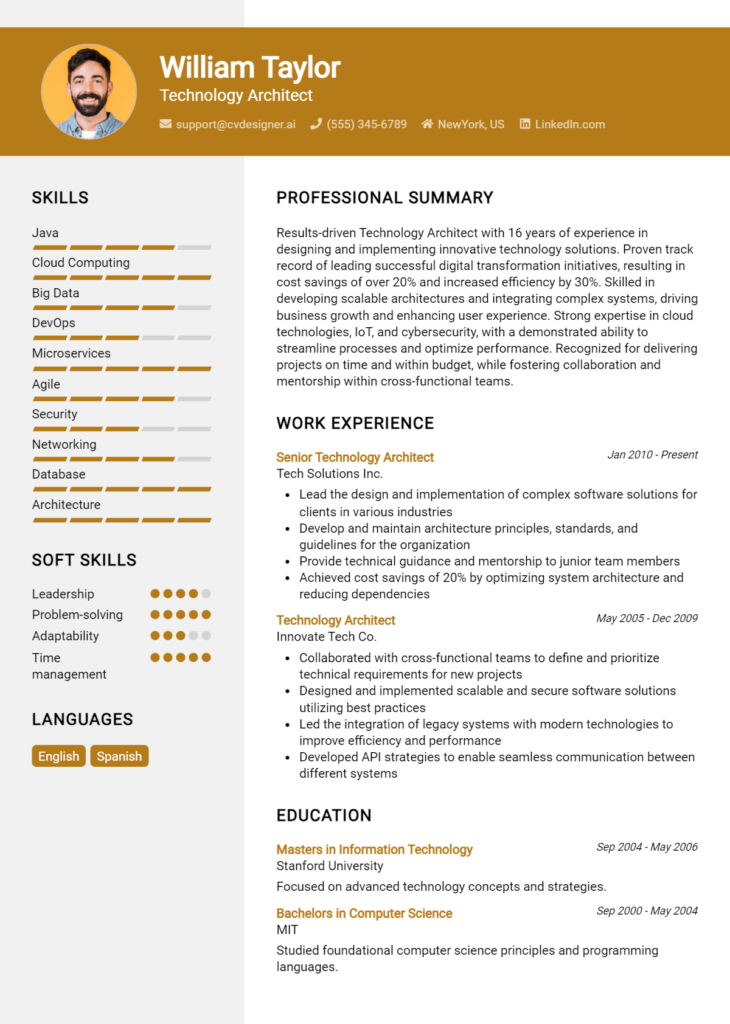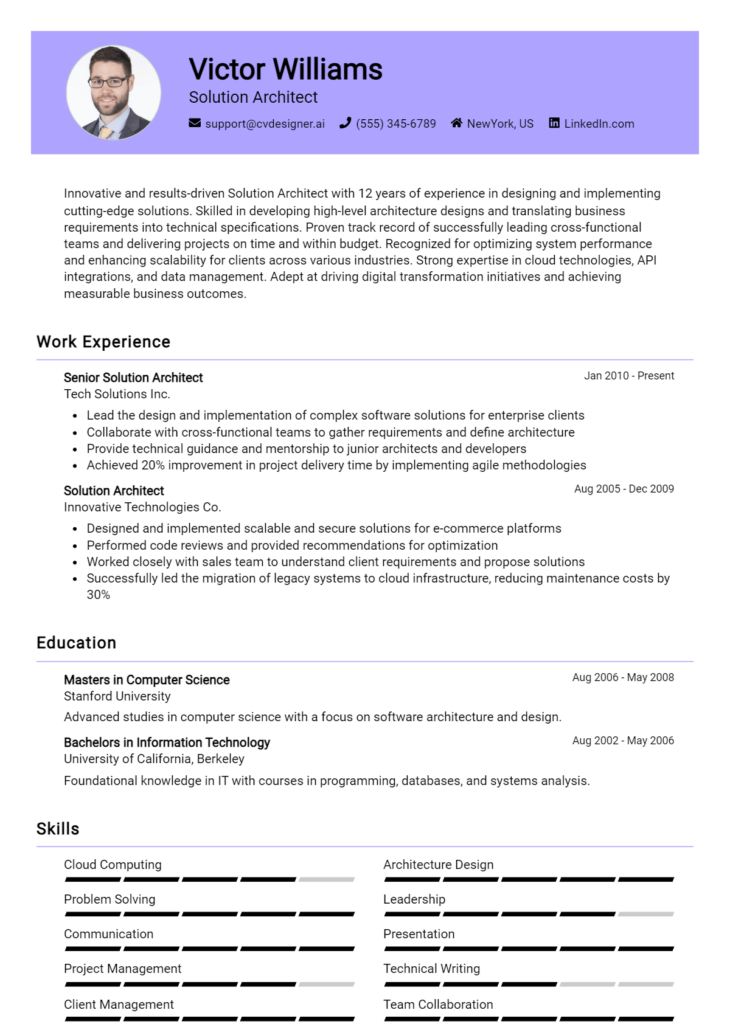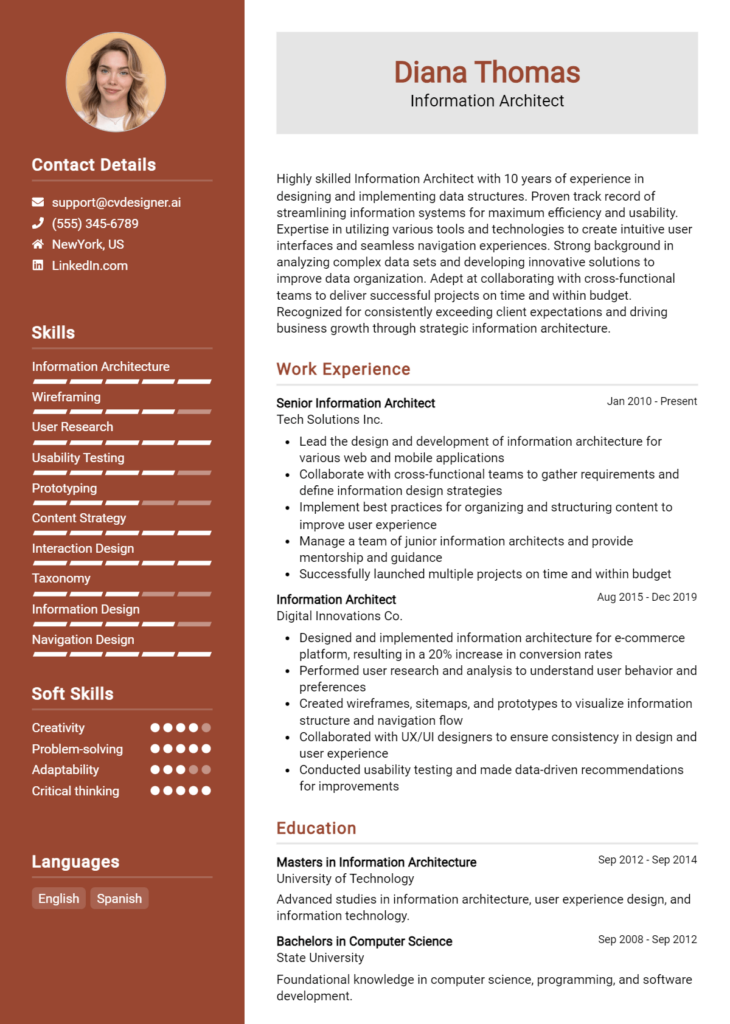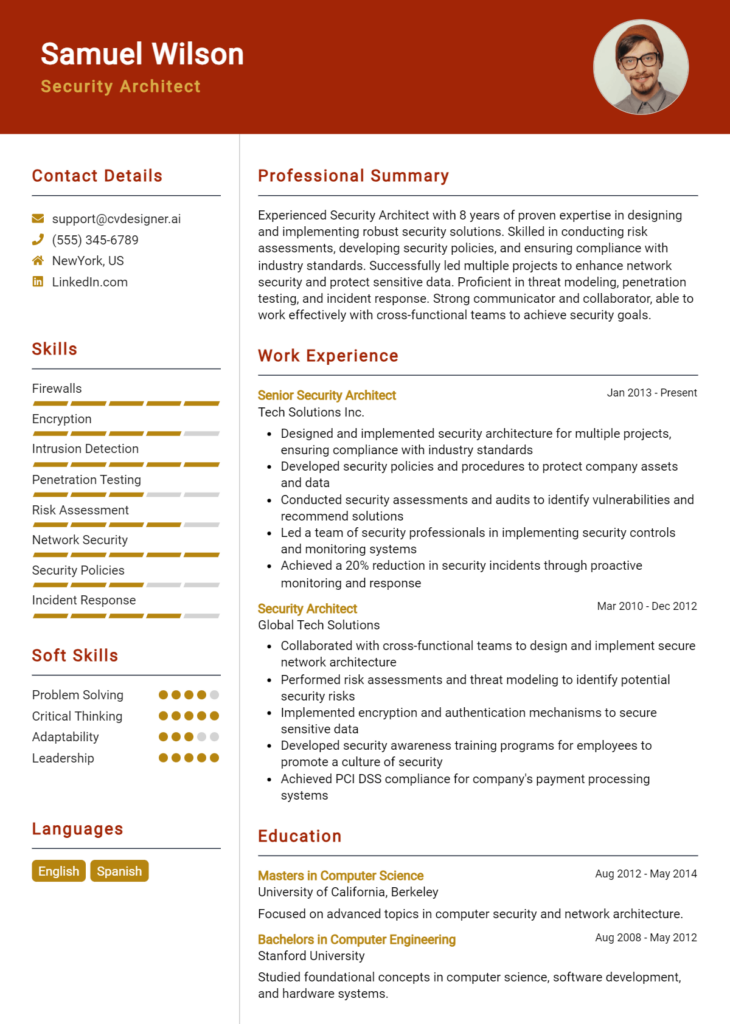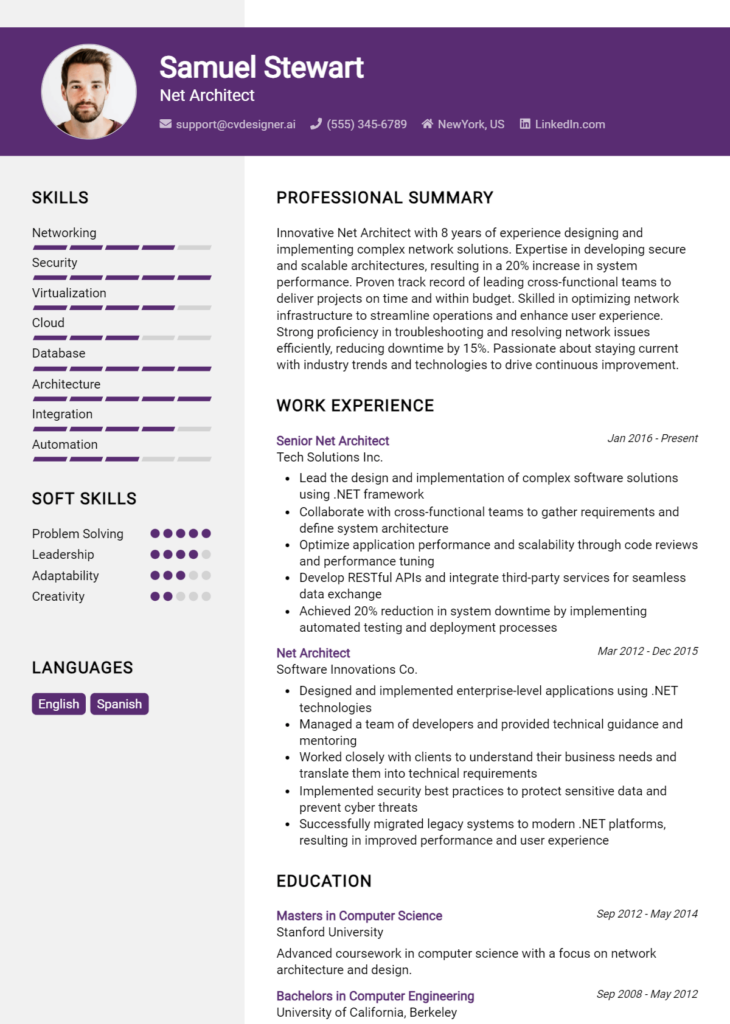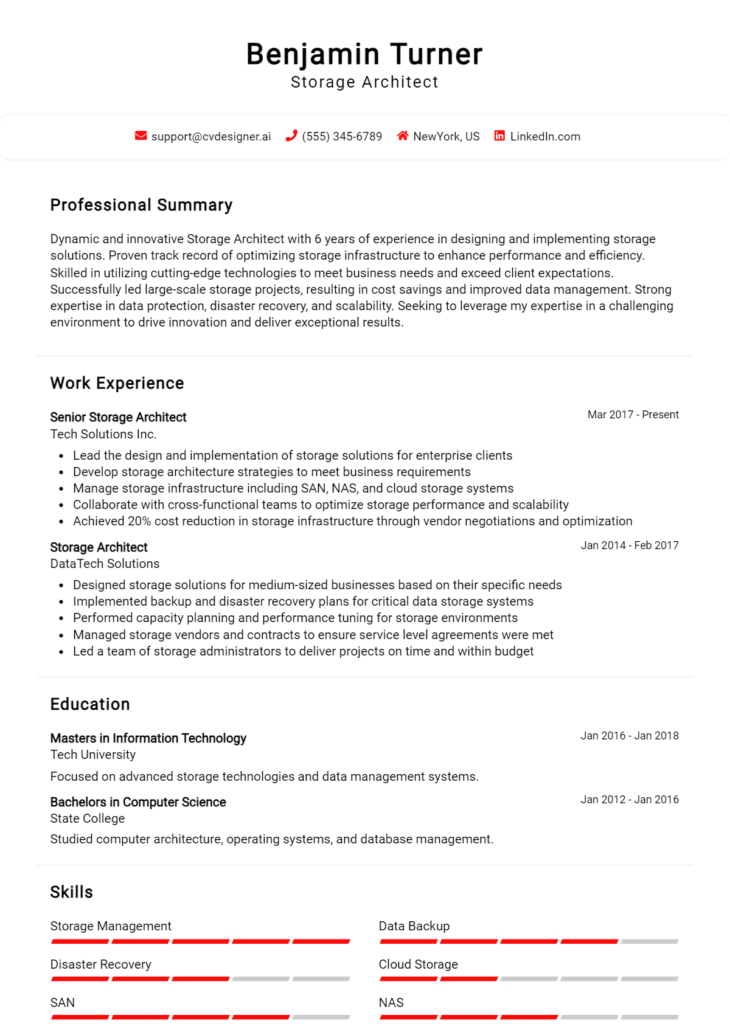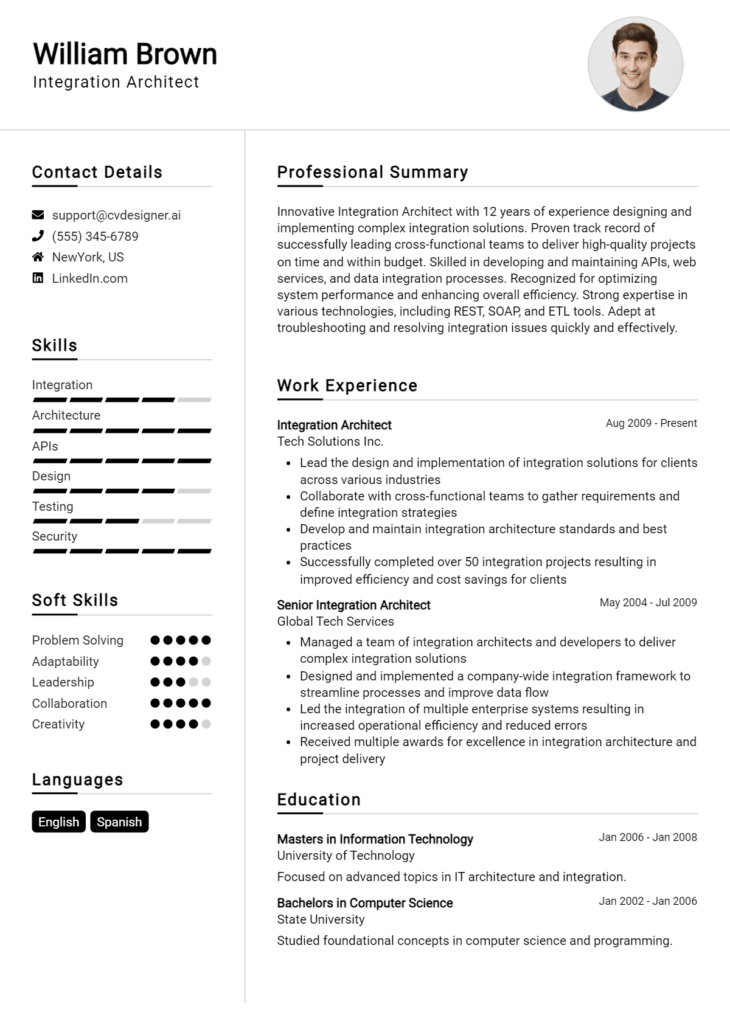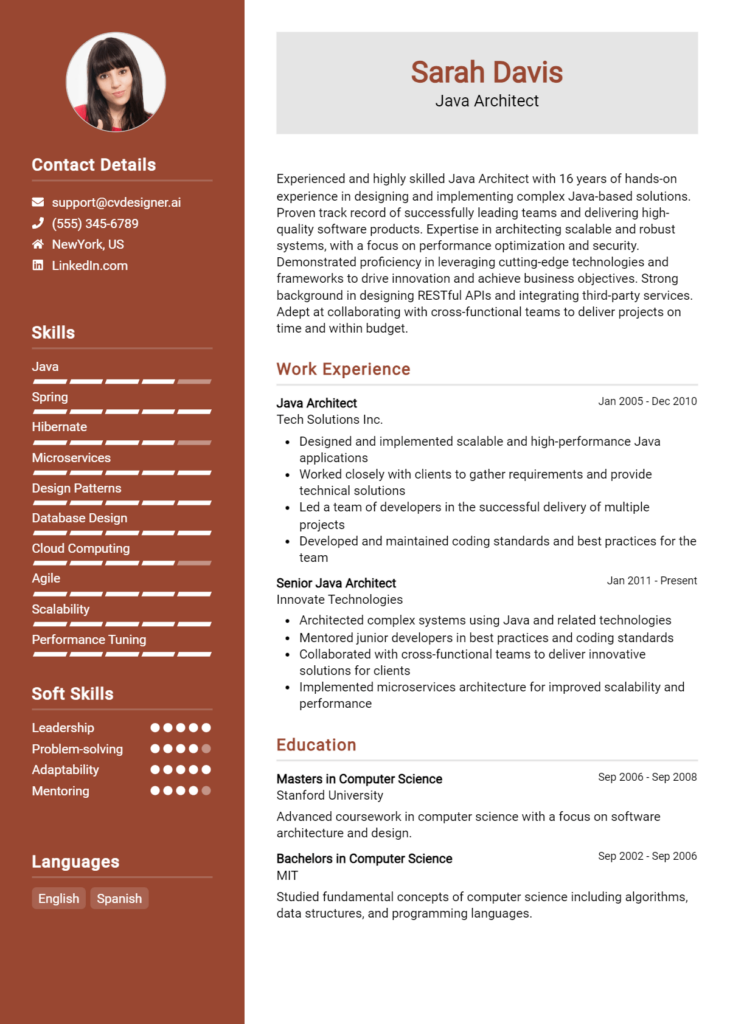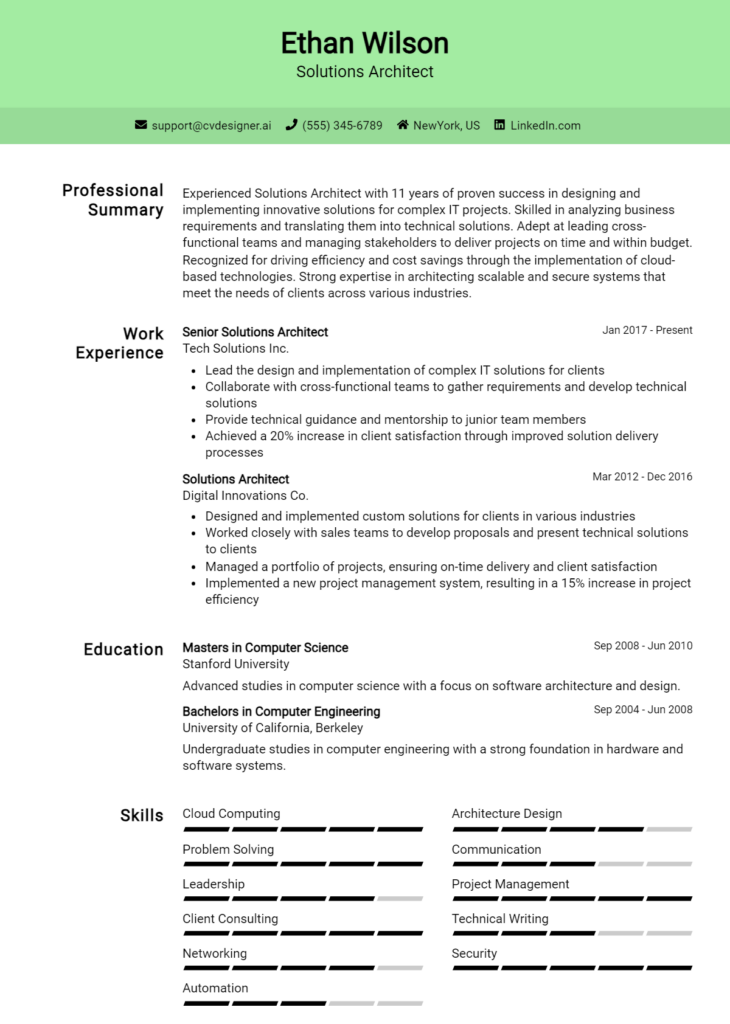Most Popular Enterprise Architect Resume Examples
Explore additional Enterprise Architect resume samples and guides and see what works for your level of experience or role.
As organizations increasingly rely on technology to drive their business strategies, the role of an Enterprise Architect has never been more critical. An Enterprise Architect serves as the bridge between business goals and IT strategy, ensuring that technology investments align with and support the organization’s objectives. With such a pivotal role, crafting a standout resume is essential to capture the attention of hiring managers. A well-crafted resume not only showcases your technical acumen and strategic thinking but also demonstrates your ability to lead and innovate in a complex environment.
In this comprehensive guide to writing an Enterprise Architect resume, we will explore the core responsibilities and essential skills required for success in this role. You’ll learn about the best formats to use when structuring your resume, as well as common mistakes to avoid that could hinder your chances of landing an interview. We’ll provide resume examples tailored to various experience levels, ensuring that whether you’re a seasoned professional or just starting your career, you have the resources you need to succeed. Additionally, we’ll share valuable tips on effective resume writing techniques and how to select the right resume templates that reflect your professionalism and expertise. Stay tuned to elevate your resume and enhance your job prospects in this dynamic field!
Key Responsibilities and Skills for a Enterprise Architect
Enterprise Architects play a crucial role in aligning an organization's IT strategy with its business goals. They are responsible for designing and managing the overall architecture of the organization’s systems and processes, ensuring that technology solutions are scalable, secure, and efficient. Their key responsibilities typically include:
- Developing and maintaining the enterprise architecture framework and methodology.
- Collaborating with stakeholders to understand business requirements and translate them into technical solutions.
- Evaluating and selecting technology platforms and tools that align with the organization’s goals.
- Ensuring that all systems and processes are integrated and operate seamlessly within the enterprise architecture.
- Conducting risk assessments and ensuring compliance with relevant regulations and standards.
- Providing leadership and guidance to IT teams throughout the project lifecycle.
- Monitoring industry trends and emerging technologies to inform architectural decisions.
Essential skills required for an Enterprise Architect include:
- Strong understanding of enterprise architecture frameworks (e.g., TOGAF, Zachman).
- Proficiency in various IT domains such as cloud computing, cybersecurity, data management, and application development.
- Excellent communication and interpersonal skills to work effectively with technical and non-technical stakeholders.
- Analytical and problem-solving abilities to assess complex systems and develop effective solutions.
- Project management skills to oversee architecture-related projects.
- Knowledge of business processes and how technology can enhance efficiency.
Highlighting these skills effectively in your resume skills section is vital for making a strong impression on potential employers. Tailoring your listed responsibilities and skills to match the specific job description can set you apart from other candidates. When crafting your CV, consider how these skills demonstrate your qualifications and experience, ultimately showcasing your capability to fulfill the role of an Enterprise Architect.
Best Resume Format and Structure for a Enterprise Architect
When crafting a resume for the role of an Enterprise Architect, it is crucial to present your qualifications and experience in a clear, organized manner that highlights your expertise. Below is a detailed guide on the best resume format and structure, focusing on key sections to include:
Contact Information
- Start with your full name at the top of the resume.
- Include your phone number, email address, and LinkedIn profile (if applicable).
- You may also add your location (city and state) but omit the full address for privacy reasons.
Professional Summary
- Write a concise summary (2-4 sentences) that encapsulates your experience, skills, and what you bring to the role.
- Focus on your years of experience, specific areas of expertise, and any notable achievements.
- Tailor this section to align with the job description to make it relevant.
Work Experience
- List your work experience in reverse chronological order, starting with your most recent position.
- For each role, include the job title, company name, location, and dates of employment.
- Use bullet points to describe your key responsibilities and achievements, focusing on quantifiable results (e.g., "Led a team to reduce operational costs by 20% through innovative architectural solutions").
- Highlight specific projects or technologies you've worked with that are relevant to enterprise architecture.
Education
- Include your highest degree first, followed by the institution name, location, and graduation date.
- Mention any relevant coursework or projects that align with enterprise architecture.
- If you have additional certifications (diplomas, training) relevant to the field, you may include them here or in a separate Certifications section.
Skills
- Create a list of key skills relevant to the Enterprise Architect role (e.g., cloud architecture, enterprise application integration, IT governance frameworks, etc.).
- Consider breaking this section into subcategories (e.g., Technical Skills, Soft Skills) to enhance clarity.
- Use keywords from the job description to optimize your resume for applicant tracking systems.
Certifications
- List any relevant certifications, such as TOGAF, AWS Certified Solutions Architect, or Certified Information Systems Security Professional (CISSP).
- Include the certifying body and the date obtained to showcase your commitment to professional development.
Additional Sections (Optional)
- Professional Affiliations: Mention any relevant organizations or groups you are part of.
- Publications/Presentations: If you've authored articles or delivered talks on enterprise architecture topics, include them.
- Volunteer Experience: This can demonstrate leadership and community involvement if relevant to the role.
Formatting Tips
- Use a clean, professional layout with consistent fonts and sizes. A simple font like Arial or Calibri is recommended.
- Keep your resume to one or two pages, focusing on quality over quantity.
- Utilize white space effectively to enhance readability.
- Use bold and italics strategically to emphasize important information without overwhelming the reader.
Choosing the right resume format, such as chronological or functional, largely depends on your career progression. For an Enterprise Architect, a chronological format is often preferred, as it allows you to present a clear timeline of your experience.
The resume format you choose should complement a corresponding cover letter format. Ensure that both documents have a consistent look and feel, using similar font styles and sizes. The cover letter should elaborate on your professional summary, providing a narrative that connects your experiences and aspirations with the specific needs of the employer. Take care to address the hiring manager directly and express enthusiasm for the opportunity, while also summarizing key highlights from your resume. This cohesive approach will create a strong impression and enhance your overall application.
Writing Tips and Best Practices for a Enterprise Architect Resume
When crafting a resume as an Enterprise Architect, it's essential to present your skills and experiences in a clear, impactful way that resonates with potential employers. Focus on highlighting your technical proficiency, strategic thinking, and successful project implementations while ensuring your formatting is professional and easily readable. Utilize resume writing tips to enhance the visual appeal of your document. Remember, a well-structured resume not only showcases your qualifications but also demonstrates your attention to detail—a key trait for an Enterprise Architect. As you apply these practices, consider how they can also elevate your cover letter.
- Use strong action verbs to convey your accomplishments, such as "designed," "implemented," "orchestrated," and "optimized."
- Quantify your achievements wherever possible, including metrics like cost savings, improved processes, or successful project completions.
- Incorporate industry-specific keywords to pass through applicant tracking systems and align your experience with the job description.
- Organize your resume into clear sections (e.g., Summary, Skills, Experience, Education) to improve readability and flow.
- Tailor your resume for each application, focusing on the skills and experiences that are most relevant to the specific job.
- Highlight major projects or initiatives you led or contributed to, emphasizing your role and the outcomes achieved.
- Keep your resume concise, ideally within one to two pages, ensuring every word adds value to your narrative.
- Include any relevant certifications or continuing education that demonstrate your commitment to professional development in the field.
Common Mistakes to Avoid in a Enterprise Architect Resume
Crafting an effective resume as an Enterprise Architect requires careful attention to detail and a clear presentation of your skills and experiences. However, many candidates fall into common traps that can diminish their chances of making a strong impression. To stand out in this competitive field, it's crucial to avoid these mistakes:
- Overloading the resume with excessive information, making it difficult for recruiters to identify key qualifications.
- Using generic job descriptions that fail to highlight specific accomplishments or responsibilities.
- Neglecting to tailor the resume for the specific role, leading to a lack of relevance.
- Focusing too heavily on technical skills without showcasing leadership and strategic thinking abilities.
- Failing to quantify achievements with metrics, which can effectively demonstrate the impact of your work.
- Ignoring the importance of formatting, resulting in a cluttered or unprofessional appearance.
- Using jargon or industry-specific language that may not be understood by all readers.
- Omitting key certifications or relevant training that can strengthen your candidacy.
- Not including a summary or objective statement that succinctly conveys your career goals and value proposition.
- Forgetting to proofread for spelling and grammatical errors, which can undermine your professionalism.
To ensure your resume is polished and effective, consider reviewing common mistakes to avoid in a resume. Additionally, don't overlook the importance of a well-crafted cover letter; check out the common cover letter mistakes that should also be avoided to enhance your overall application.
Sample Enterprise Architect Resumes
As an Enterprise Architect, you play a critical role in aligning an organization's IT strategy with its business goals. Crafting a compelling resume is essential to showcase your skills, experience, and vision. Below are three sample resumes that cater to different levels of experience and career paths within the field of enterprise architecture. Whether you're an experienced professional, an entry-level candidate, or looking to transition into this role from another field, these examples can serve as a guide for creating your own standout resume. Don’t forget to explore more resume examples for additional inspiration, and consider corresponding cover letter examples to complete your job application package.
Experienced Enterprise Architect Resume
John Doe
1234 Elm Street
City, State, ZIP
(123) 456-7890
john.doe@email.com
Summary
Dynamic and results-driven Enterprise Architect with over 10 years of experience in designing and implementing scalable IT infrastructures. Proven track record of aligning technology with business goals, optimizing processes, and leading cross-functional teams. Strong expertise in cloud computing, enterprise resource planning (ERP), and systems integration.
Professional Experience
Senior Enterprise Architect
XYZ Corporation, City, State
January 2018 - Present
- Lead the architectural design for enterprise-wide solutions, resulting in a 30% increase in operational efficiency.
- Collaborate with stakeholders to define business requirements and translate them into technical specifications.
- Implement cloud migration strategies that reduced IT costs by 25% over three years.
Enterprise Architect
ABC Solutions, City, State
June 2015 - December 2017
- Developed and maintained the enterprise architecture framework, ensuring alignment with business strategies.
- Managed a team of architects and developers to deliver large-scale projects on time and within budget.
- Spearheaded a data governance initiative that improved data quality and compliance across the organization.
Education
Master of Science in Information Technology
University of State, City, State
Graduated: May 2015
Bachelor of Science in Computer Science
University of State, City, State
Graduated: May 2012
Certifications
- TOGAF 9 Certified
- AWS Certified Solutions Architect
Entry-Level Enterprise Architect Resume
Jane Smith
5678 Maple Avenue
City, State, ZIP
(987) 654-3210
jane.smith@email.com
Summary
Motivated and detail-oriented graduate with a strong foundation in information technology and architecture principles. Eager to apply technical skills and knowledge in a challenging Enterprise Architect role. Committed to continuous learning and professional development.
Education
Bachelor of Science in Information Technology
University of State, City, State
Graduated: May 2023
Relevant Coursework
- Enterprise Architecture Frameworks
- Cloud Computing
- Systems Analysis and Design
- Data Management
Internships
IT Intern
Tech Innovations, City, State
June 2022 - August 2022
- Assisted in the design and implementation of IT solutions for various projects.
- Collaborated with senior architects to document system requirements and architectural designs.
- Participated in team meetings to discuss project progress and challenges.
Skills
- Familiar with TOGAF and Zachman frameworks
- Proficient in cloud services (AWS, Azure)
- Strong analytical and problem-solving abilities
- Excellent communication and teamwork skills
Career Changer Resume
Michael Brown
9101 Oak Drive
City, State, ZIP
(555) 123-4567
michael.brown@email.com
Summary
Experienced project manager transitioning to Enterprise Architect with a background in IT project delivery and strategic planning. Proven ability to manage cross-functional teams and deliver solutions that meet business needs. Looking to leverage project management expertise and technical knowledge to contribute to enterprise architecture initiatives.
Professional Experience
Project Manager
Global Solutions, City, State
March 2015 - Present
- Led multiple IT projects with budgets exceeding $1M, ensuring timely delivery and stakeholder satisfaction.
- Collaborated with various departments to gather requirements and define project scope, aligning IT solutions with business objectives.
- Developed and maintained project documentation, including technical specifications and user manuals.
IT Support Specialist
Tech Services, City, State
June 2012 - February 2015
- Provided technical support and troubleshooting for software and hardware issues, improving customer satisfaction ratings.
- Assisted in the implementation of new IT systems and trained staff on their usage.
Education
Bachelor of Arts in Business Administration
University of State, City, State
Graduated: May 2011
Skills
- Strong understanding of enterprise architecture concepts
- Experience with project management methodologies (Agile, Waterfall)
- Excellent communication and leadership skills
- Knowledge of cloud technologies and IT infrastructure
These resumes illustrate the diverse backgrounds and experiences that can lead to a successful career as an Enterprise Architect. Each example emphasizes relevant skills and experiences tailored to the respective candidate's level and career path.
Checklist for a Enterprise Architect Resume
- Proofread for Errors: Carefully check for spelling, grammar, and punctuation mistakes. Consider using tools like Grammarly or an AI resume builder to catch any overlooked errors.
- Tailor Your Content: Customize your resume for each job application by incorporating keywords and phrases from the job description. This shows that you are a strong match for the specific role.
- Check Formatting Consistency: Ensure that fonts, sizes, bullet points, and spacing are uniform throughout the resume. Consistency in formatting enhances readability and professionalism.
- Highlight Relevant Experience: Focus on your most relevant work experience and achievements. Use quantifiable metrics to demonstrate your impact in previous roles.
- Include Key Skills: List skills that are pertinent to the enterprise architect role, such as cloud architecture, enterprise resource planning (ERP), and strategic planning, ensuring they align with the job description.
- Use Action Verbs: Start bullet points with strong action verbs to convey your contributions effectively. Words like "developed," "led," and "implemented" create a more dynamic presentation of your experience.
- Limit Length: Aim for a concise resume, ideally one to two pages. Be selective about the information you include, focusing on the most impactful and relevant experiences.
- Verify Contact Information: Double-check that your contact details are current and correctly formatted. Include a professional email address and ensure your LinkedIn profile is up to date.
- Seek Feedback: Consider having a mentor or colleague review your resume. Fresh eyes can identify areas for improvement that you might have missed.
- Utilize AI Tools: For an organized and polished resume, consider using an AI resume builder. It can help structure your content effectively and enhance overall presentation.
Remember, a similar checklist can be followed for creating a CV to ensure that all essential elements are included and well-presented.
Key Takeaways for a Enterprise Architect Resume Guide
Creating a strong Enterprise Architect resume is essential to showcasing your expertise and securing the job you desire. By utilizing the examples and tips provided, you can effectively highlight your skills, experience, and achievements in a way that captures the attention of hiring managers. Remember to tailor your resume to reflect the specific requirements of each position you apply for, emphasizing relevant projects and technologies. As a next step, consider downloading a professional resume template from resume templates to ensure your layout is polished and visually appealing. Don’t forget to complement your resume with a well-crafted cover letter by checking out our cover letter templates. For those who prefer an interactive approach, our best resume maker can guide you through the process of creating a standout resume that will help you take your career to new heights. Start crafting your professional narrative today and open the door to exciting opportunities in the field of enterprise architecture!

